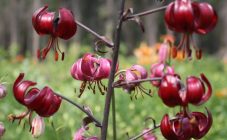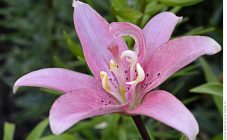Content:
The tree lily is a mysterious and ambiguous plant. Some gardeners admire it due to its beauty, and some are firmly convinced that such a culture does not exist in nature. But, despite such different opinions of people, lily tree seedlings are freely available in garden stores. Saplings can be used to grow beautiful flowers. Or is it a tree with flowers like a lily? Before growing a plant, be sure to familiarize yourself with the intricacies of its cultivation.
Tree lily - what is it
Gardeners who have experience growing daylilies are convinced that the tree lily simply does not exist. Numerous descriptions and photographs indicate that there is only a certain type of lily, characterized by tall and dense shoots, which have rather large inflorescences. Sometimes these shoots vaguely resemble a young tree, but they are still a flower.
The origin of the lily has its roots in Canada, where breeders have obtained a hybrid variety of a tree plant. Because of their rather large growth, tree lilies are called Goliaths here, like a giant from ancient Greek myth or legend. Growth, stunning aroma and gorgeous blossoms make the culture popular in florist circles.
The lily tree is the result of crosses. And the hard work that the breeders carried out led to the production of giant plants, which are distinguished by their growth (up to 2.5 m) and large flowers. Inflorescences attract with a varied palette of shades and a delicate aroma. But it is worth noting that the tree lily, in most cases, blooms only once every 5 years. A brief description of the lily tree can be represented by the following characteristics:
- the perennial bulbous plant has hollow stems;
- heart-shaped leaves alternately decorate long petioles;
- flowers are turbid, goblet or long-tubular, located on a powerful peduncle, and their diameter is at least 30 cm.
The period of active flowering of the tree lily begins in mid-July and lasts for one month.
Characteristics of species and varieties of crops
One of the popular varieties of tree lilies is Cardiocrinum, better known as the heart lily. The plant is bulbous, the diameter of the hollow stems is 5 cm. The foliage at first glance resembles the shape of a heart, it has reticular venation, and it is attached to the plant stem with long petioles. The inflorescences are characterized by a pale green or white tint and a tubular structure.
The giant heart-shaped lily prefers to grow on the mountain slopes, its natural habitat is the Himalayas. The plant reaches a height of 3 m, and begins to bloom in mid-August. Inflorescences consist of large pink flowers, usually their number is 20 pcs.
A popular hybrid tree plant is the Honeymoon lily. The characteristics of culture include:
- high rates of winter hardiness (lilies are not afraid even of severe frosts down to -30 degrees below zero);
- the height of an adult tree is 2 m;
- beautiful buds have an extraordinary moon-honey color and rich aroma.
When planting hybrid varieties of tree lilies, one must take into account the fact that they all differ in stem height, flowering duration, inflorescence shades and care requirements.
Another common variety of hybrid tree lily is Preti Vumen, which has a soft creamy white color. The Preti Wumen lily tree was obtained by crossing the oriental lily and the Regale tube lily. The inflorescence consists of 30 small, cupped or funnel-shaped flowers with a pleasant aroma.
This variety begins to bloom in the second half of summer. The stem is durable, and it reaches 2 m in height.If favorable conditions were created during cultivation, the culture grows up to 2.7 m in 3 years. The variety has increased immunity against diseases, as well as good winter hardiness.
Lily-tree: planting and care in the open field
The care and cultivation of tree lilies in the open field differs in some features throughout the entire flowering and active growth. Using the example of growing the Purpl Prince variety, you can draw up a step-by-step algorithm for planting a tree lily, it will be similar in relation to other daylily varieties.
The lily tree prefers a slightly acidic soil, in which the level of mineral fertilizers is increased (excluding fresh organic matter). In no case should the culture be close to groundwater; the optimal place for planting a plant is flower beds on elevations. With the help of river sand and gravel, you need to create drainage and cover the preliminary landing site with it.
It is necessary to plant water lilies of a tree lily in the first half of autumn or in spring - in late April or early May. Sand should be poured into the planting hole, and the planting depth should be no more than 20 cm from the root system to the top layer of the soil. The final step is soil mulching. Caring for a planted plant consists of several main points:
- regular watering;
- top dressing with potash fertilizers;
- preparing the plant for wintering.
The tree lily can be propagated by the seed method, as well as by bulbs, babies or cuttings. If you take, for example, the lily Pretty Wumen, it propagates by bulbs, but it is worth noting that this method is very slow and laborious. And all because the bulbs are sensitive to excessive moisture and with the onset of autumn they can deteriorate or completely rot.
Lily babies can only be harvested after several years, when the culture grows well and begins to bloom. The most mature trees can organize whole nests, consisting of bulbs, which can be safely planted.
The seed method of reproduction of tree lilies is a collection of those seeds from the plants that are at the top of the stem, in a special box (it is recommended to collect planting material in the fall). Until the first cold weather comes, part of the stems with capsules must be cut off and placed in a warm place for final ripening. It is necessary to plant ripe seeds immediately, they are able to quickly lose germination.
Major diseases and pests of culture
When growing lilies, you can face the fact that their bulbs are affected by various diseases, small pests and rodents. Succulent stems and fleshy foliage can be severely damaged by fungal and viral diseases.These negative factors can worsen the condition of flowers and even lead to their death.
Fungal diseases of tree lily:
- gray rot,
- fusarium,
- anthracnose,
- blue mold.
The most dangerous disease is gray rot. It spreads from the lower leaves, gradually affecting the entire flower. A plant disease can be identified by brown round spots, which increase in size and over time become brown mucous tissue covered with a gray bloom.
It is very difficult to deal with gray mold, it is much easier to prevent its appearance. To do this, before planting the bulbs, they must be treated in a solution of a dressing agent or Fundazole. Other fungal diseases of tree lilies can be prevented by spraying the bulbs.
With a spider mite, experts advise to fight using a soap solution or acaricide (for example, Aktofit). In an unpainted bud, a lily fly can settle, which eats the anthers of stamens and pistils. With the help of Karbofos or any other insecticide, it is necessary to destroy those buds that have been damaged.
The lily tree is a lush, tall and showy plant that must be looked after. You also need to make sure that the culture is not exposed to direct sunlight. Subject to the care recommendations, after three years, the lily will delight its owner with its color.

















God, what nonsense ... Especially the description and photo of Pretty Woman)))